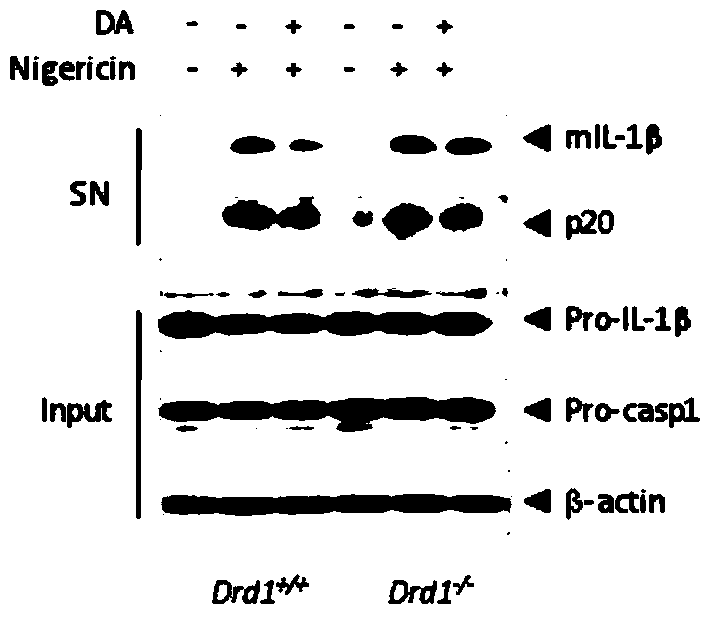DRD1 protein and application of agonists of DRD1 protein in preparation of medicine for treating related inflammatory diseases of NLRP3 inflammasome
A technology for inflammatory diseases and inflammasomes, applied in the field of DRD1 protein and its agonists, which can solve problems such as no successful examples of inflammatory diseases
- Summary
- Abstract
- Description
- Claims
- Application Information
AI Technical Summary
Problems solved by technology
Method used
Image
Examples
Embodiment 1
[0056] Example 1, DA and its agonists inhibit the activation of macrophage NLRP3 inflammasome in vitro
[0057] 1. DA inhibits the secretion of IL-1β
[0058] 1. On the first day, divide BMDM onto a twelve-well plate, 5*10 per well 5 cells.
[0059] 2. On the second day, the supernatant was first aspirated, and 500 μl of opti-MEM containing ultra-LPS (500 ng / ml) was added to each well for three hours. Divided into five groups with three replicate wells in each group.
[0060] The first group, the negative control group.
[0061] In the second group, Nigericin with a final concentration of 10 μM was added to each well for half an hour.
[0062] In the third group, DA with a final concentration of 0.15 mM was added to each well for three hours, and Nigericin with a final concentration of 10 μM was added for half an hour.
[0063] In the fourth group, DA with a final concentration of 0.2 mM was added to each well for three hours, and Nigericin with a final concentration of 1...
Embodiment 2
[0144] Example 2, DRD1 protein can inhibit central system inflammation
[0145] 1. DA can inhibit the activation of microglial inflammasome through DRD1
[0146] 1. On the first day, divide the microglial cells of wild mice (WT) and Drd1-deficient mice into twelve-well plates, 1*10 per well 6 cells.
[0147] 2. On the second day, the supernatant was first aspirated, and 500 μl of opti-MEM containing ultra-LPS (500 ng / ml) was added to each well for three hours. Each of the two types of microglia was divided into three groups, a total of six groups, and each group had three replicate wells.
[0148] The first group, WT mouse microglia, negative control group.
[0149] In the second group, WT mouse microglial cells, Nigericin with a final concentration of 10 μM was added to each well for half an hour.
[0150] In the third group, WT mouse microglial cells, DA with a final concentration of 0.2 mM was added to each well for three hours, and Nigericin with a final concentration ...
Embodiment 3
[0184] Example 3, DRD1 protein can inhibit peripheral system inflammation
[0185] 1. DA can inhibit LPS-induced peripheral inflammation
[0186] 1. Select 8-12 week old wild mice (WT), and divide them into three groups with three mice in each group.
[0187] 2. The first group, wild-type mice, was intraperitoneally injected with PBS as a negative control
[0188] The second group, wild-type mice, intraperitoneally injected with LPS, the injection dose was 20mg / kg
[0189] The third group, wild-type mice, were injected intraperitoneally with LPS and DA at the same time, wherein the injection dose of LPS was 20 mg / kg, and the injection dose of DA was 50 mg / kg
[0190] 3. After four hours, collect the blood by pulling out the eyeball, let it stand at room temperature for half an hour, then centrifuge at low speed for half an hour, and collect the serum.
[0191] 4. The serum obtained in step 3 is used for the determination of cytokines such as IL-1β and IL-18 by ELISA method....
PUM
 Login to View More
Login to View More Abstract
Description
Claims
Application Information
 Login to View More
Login to View More - R&D Engineer
- R&D Manager
- IP Professional
- Industry Leading Data Capabilities
- Powerful AI technology
- Patent DNA Extraction
Browse by: Latest US Patents, China's latest patents, Technical Efficacy Thesaurus, Application Domain, Technology Topic, Popular Technical Reports.
© 2024 PatSnap. All rights reserved.Legal|Privacy policy|Modern Slavery Act Transparency Statement|Sitemap|About US| Contact US: help@patsnap.com










